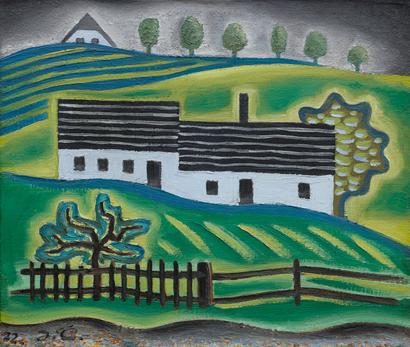Lot #93

Josef Čapek (1887–1945)
Houses on the Hillside
Estimate: 4,000,000 CZK - 7,000,000 CZK
Starting price: 3,500,000 CZK
5,100,000 CZK
This painting fully describes Čapek’s optimistic view of the world at the beginning of the 1920s, when, enchanted by the simple life values, he built his concept of “the humblest art”. For him, the period of the First Czechoslovak Republic was happy and productive in both the visual arts and literature. He leaned towards naive painting inspired by folk art and tradition, using reduced vehicles of expression and pure colours. He worked closely with his brother Karel in the field of literature and on several plays. This interest influenced the presented work, Houses on the Hillside, which, at first glance, may seem like a theatre backdrop. In 1922, Čapek created several similarly rendered oils with a stylised landscape (House with a Pond I, House with a Pond II, House in the Rocks, Landscape with a House). The composition with a rhythmically undulating landscape evokes a feeling of closeness and peaceful tranquillity. The overall impression is poetic and slightly dreamy, pointing to Čapek’s unique approach to depicting the landscape, which combines modernist tendencies with a love of traditional village life.
The painting was exhibited in the Prague Castle Riding School at the retrospective exhibition Josef Čapek (1887–1945), Paintings and Drawings, National Gallery Prague 1979, cat. No. 88. According to the Main Customs Office in Prague stamp, we can assume that it was presented at a foreign exhibition, likely one of the exhibitions of the Tvrdohlaví group (e.g. the exhibition at the John Levy Galleries in Paris in 1924 or the exhibition at the Hagenbund in Vienna in the same year). A photograph exists of the interior of Čapek’s house in which the work is featured. The painting comes from the artist’s property, with the inscription “pí. Scheinpflugová” on the stretcher. It belonged to Karel Čapek and Olga Scheinpflugová, subsequently acquired by Mrs. Scheinpflugová’s sister, Božena Konrádová. It later became the property of Karel Scheinpflug and his heirs, now from an important Prague collection. Assessed during consultations by prof. J. Zemina and PhDr. R. Michalová, Ph.D. The expertise of PhDr. P. Pečinková, CSc, is attached.



